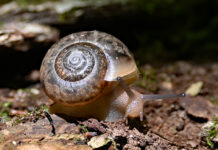
Most people don’t know that freshwater mussels exist. The mussels in restaurants come from salt water, not fresh. Blending in with the rocks on the bottoms of rivers, lakes and streams, the freshwater varieties do a great job of remaining incognito.
Yet these unseen creatures are key to their watery environments, each filtering at least eight gallons of water a day. They are canaries in the coal mine for water quality, and fascinating in the deception, trickery and even aggression they employ during reproduction.
Unfortunately, freshwater mussels also have the distinction of being the most imperiled group of creatures in North America. Of the 300 species native to the continent, about 70% are extinct, endangered or threatened while those numbers for bird and mammal species are only in the mid-teens. Last September, the U.S. Fish and Wildlife Service proposed adding salamander mussels to the endangered list.
Expanding conservation efforts
But that same month, the dedication of the new Watters Aquatic Conservation Center as part of the Columbus Zoo and Aquarium gave staff with the zoo, the Ohio Division of Wildlife and Ohio State University a bigger facility and new opportunities to reverse the mussels’ downward trend.
Dr. Ieva Roznere, research scientist with OSU and science director of the Watters Center, didn’t know about freshwater mussels until she did her Ph.D. and postdoctoral work under Dr. Tom Watters, who started the zoo’s Freshwater Mussel Conservation and Research Center in 2002. He prepared Roznere to take over when he retired, but he passed away in 2019.
A $500,000 grant from the Ohio Department of Natural Resources paid to renovate the former Jeffrey Manufacturing Company lodge and retreat into the new center named for Watters. The remodeling gave the mussel researchers, most of whom hail from OSU, a larger space to work with and care for the 22 mussel species and 250 individuals currently residing there.
Under the surface
Mussels have only one foot to stand on, so they don’t get around much. They spend most of their lives buried under rocks and sediment with only a siphon sticking up. As they pick out food items, they also pull unwanted gunk out of the water and sink it under the sediment. That includes pollutants, which they are surprisingly good at handling.
They only come to the surface — the surface of the sediment, not the water — to mate. The male releases sperm into the water that the female takes in through her siphon. When the eggs are fertilized, she nourishes them in her marsupial gills.
The eggs become thousands of microscopic larvae called glochidia. However, if the mother just allowed the larvae to ooze out and settle around her, they’d be exposed to predators and few if any would survive.
That’s where the fish come in.
Finding fish friends
Freshwater mussels require the help of a host fish that they “infect” with what amount to exploding packets of larvae, which can then attach to the fish. The exception is the salamander mussel that uses the mudpuppy, an amphibian, to host its offspring.
“A life cycle that involves larvae attaching to fish is unique to our freshwater mussels,” Roznere said.
While some species of mussels can use a wide variety of fish to host their offspring, others must stick to only one species. For instance, the pocketbook mussel uses bass as hosts — largemouth, smallmouth, either one will do. To attract them, the female uses the fleshy tissue along her gills to create a lure that looks like a darter fish, one of the bass’s favorite foods.
The lure is constructed in two halves, and she pushes a packet of larvae into the middle. She then wiggles the lure with moves a professional angler would admire. When the bass goes for the bait, it gets a faceful of larvae instead.
The rainbow mussel, on the other hand, is only looking for rock bass. She creates a lure that looks like a crayfish. It can even “walk” on the bottom till the same kind of explosion occurs.
Perhaps the most impressive — and aggressive — mussels belong to a group that includes the snuffbox and northern riffleshell. These residents of the Ohio River basin are trying to attract darters.
Both have big bulges in their shells where they brood their babies. When they are ready to release the larvae, they open their shells to reveal a tiny lure.
But their conniving doesn’t stop there. When a darter comes close enough to that large space in her shell, the female mussel clamps down on its head and keeps it there until all the larvae have been released. Unfortunately, not all darters’ heads are strong enough to withstand the pressure; only those with strong bones will survive, and hopefully, transport the larvae to a suitable environment.
“The glochidia are like little Pac-Men,” said John Navarro, administrator for the Ohio Division of Wildlife’s Aquatic Stewardship program, who facilitates the work at the Watters Center.
The larvae clamp onto the gills or the skin of the host fish, which then forms something resembling cysts over them, he said. The larvae draw nutrients from the fish and drop off after a few weeks, leaving the fish none the worse for wear.
Stressed by humans
Freshwater mussels were brought to the verge of extinction not just by pollution, dredging and dams, but also the fashion industry. In the late 1800s, before the invention of plastic, mussel shells were used to make buttons. There are photos of men standing on piles of mussel shells as big as a house, Navarro said.
Mussels were also exploited for their shells to make cultured pearls, a practice that began in the 1960s but continues today, mostly overseas. Pellets are cut from the shells and then implanted in oysters, which then cover them in layers to create pearls.
Another threat comes from toxic waste, spills or other pollution events. While fish can swim away, mussels are stuck there, Navarro said. Although they can keep their shells shut for a period of time, eventually, they succumb.
However, there have also been unexplained die-offs of freshwater mussels across North America and in other countries. A 2019 article in the Smithsonian tells of die-offs three years in a row in the Clinch River, near where the borders of Kentucky, Virginia and Tennessee meet.
The first two years, only pheasantshell mussels died in droves, while other species seemed to be doing fine. The third year, not only pheasantshells died, but so did some of the other mussel species in the river.
Scientists suspect it’s some kind of disease, like a mussel equivalent of the Ebola virus. But scientists have not studied diseases in freshwater mussels, worrying instead about how they’re stressed by human impact, Roznere said.
Facilitating a comeback
That’s another reason she and others are propagating mussels in the lab. One method that they call “in vitro” involves routine checking of resident females. If their gills are flat, they’re not pregnant. If the gills are inflated, they are.
In that case, staff use a syringe to flush the almost-microscopic larvae into Petri dishes. In each dish is “a soup of yummy nutrients,” plus antibiotics and antifungals, Roznere said.
The juveniles that “transform” and develop a hardened shell are moved to aquarium tanks to grow into adults. The new center has a huge number of tanks that are all interconnected. Water from the Scioto River flows in and provides nutrients, then the “used” water flows back out into the river.
“It’s difficult to raise mussels in captivity,” Roznere explained. “We know they eat algae, but what else? We solve that problem by giving them wild water.”
Growing them in the lab greatly increases the juvenile mussels’ chances of survival. In the wild, most of the larvae will not attach to a fish, despite their mothers’ efforts. Those that do may detach from the fish only to be eaten or swept away. Or their shells fail to harden so they don’t develop into adults.
So Roznere, Navarro and their colleagues will continue their efforts to help mussels make a comeback. Right now, their research is focused on fatmucket mussels, the second most common species in Ohio. As they build new systems to grow out more for release, they will expand to endangered mussel species with descriptive names like wartyback, kidneyshell and elktoe.
It will probably be a few years until any adult mussels are released, Roznere said. Then it will be only into bodies of water that those species have inhabited in the past and where their host fish can be found.
Meanwhile, Division of Wildlife personnel will do intensive surveys of both mussels and fish at 150 locations this summer so that researchers at the Watters Center have updated information to work with. In 2025, there will be even more intense surveys of five different rivers that could provide suitable habitat for released mussels.
“Freshwater mussels have been around since the dinosaurs,” Roznere said.”We don’t want to lose them now.”










